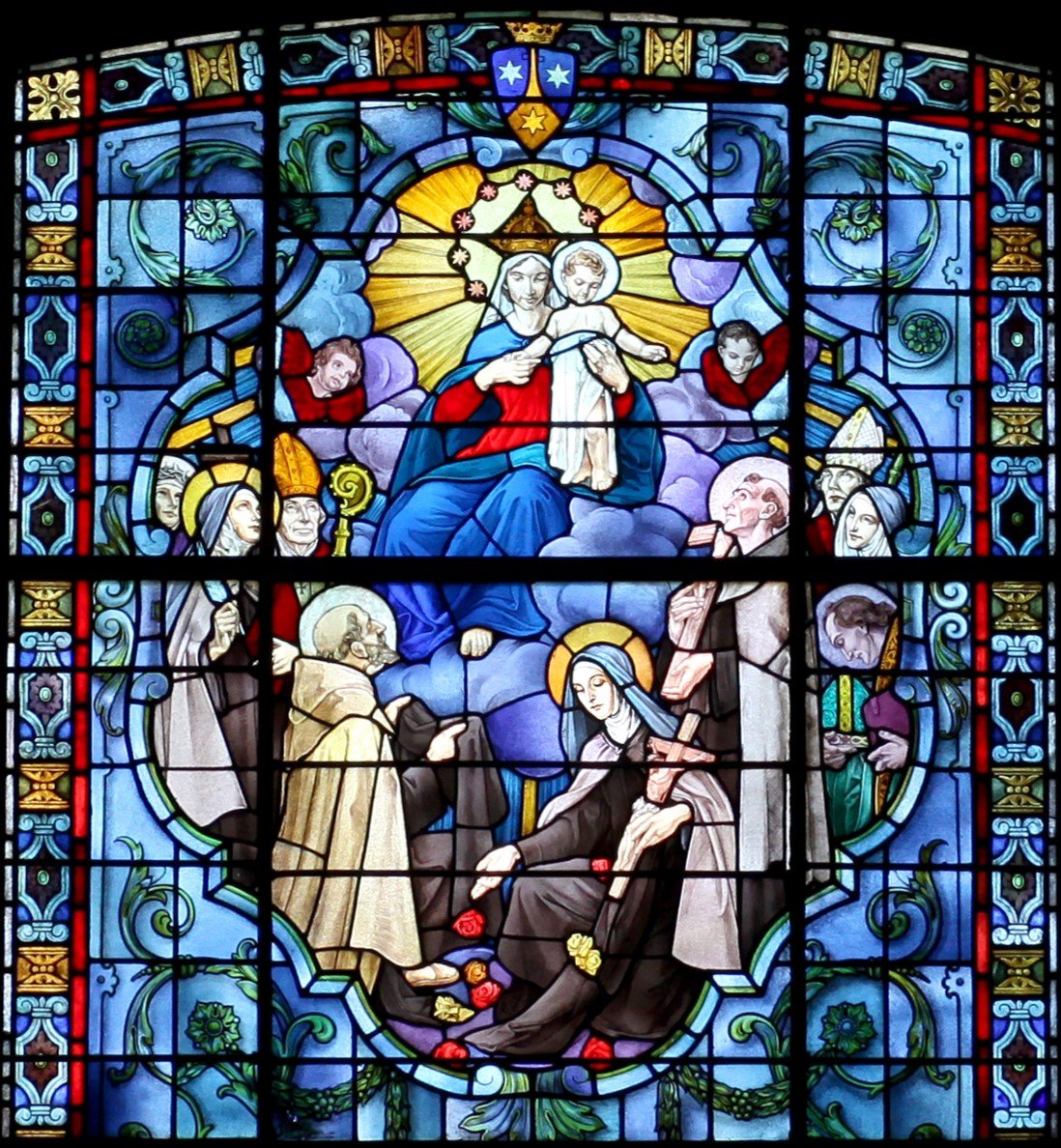Our Lady of Mt. Carmel and Carmelite Saints
The earliest Carmelites were hermits on Mt. Carmel in the Holy Land. In the 13th century, they built a chapel there for Our Lady and declared her “Lady of the Place”: the Mother, Sister, Protector, and Queen of Mt. Carmel and their community. The Order’s devotion to Mary as its model is distinctively Carmelite in its contemplative focus on the interior life and friendship with God. The Discalced Carmelites symbolize their commitment to Our Lady of Mt. Carmel in the Brown Scapular as part of their habit. Our Lady of Mt. Carmel is central to the spirituality of the Discalced Carmelites as to the Basilica of the National Shrine of the Little Flower, from its origins as Our Lady of Mt. Carmel and St. Thérèse Church.
Overlooking the main choir loft, the largest window in the Basilica honors the Blessed Virgin Mary, Queen and Mother of Carmel. The window also recounts certain Carmelite traditions and legends surrounding Our Lady. On the cover of this issue is the upper central panel of the window, depicting Our Lady surrounded by Carmelite saints. We recognize with certainty only Teresa of Jesus, with her pen, from left; Simon Stock with the Brown Scapular; Thérése, The Little Flower; and John of the Cross.
The lower central panel of the window shows Our Lady descending to Purgatory to liberate those wearing the Brown Scapular. This window shows “the Sabbatine Privilege at work,” said Fr. Sam Anthony Morello, O.C.D., a friar of the Province of St. Thérèse. The legend of an apocryphal Papal Bull claiming that Pope John XXII had received the Sabbatine Privilege from Our Lady, is depicted in the lower right window.
“At best a legend and historically unfounded,” the Sabbatine (of Saturday, the day to honor Our Lady) Privilege was condemned by the Vatican in 1613 as a “Documentum spurium,” a forgery, but the correction “didn’t take hold because the Reformation was raging,” Fr. Sam explained.
In 2000, Fr. Sam was assigned to the 2nd commission of the Vatican on the Brown Scapular and the Sabbatine Privilege. The commission was mandated by the five Carmelite provinces in the U.S. to present the official teaching of the Catholic Church and the Carmelite Orders. With Patrick McMahon, O.Carm., Fr. Sam authored a booklet, The Scapular of Our Lady of Mount Carmel: Catechesis and Ritual, containing the updated catechesis on the subject.
The upper right window shows St. Simon Stock receiving the Brown Scapular in a Marian vision in the monastery of Aylesford, England, in 1251. This event is significant historically, Fr. Sam said. As the Order settled in Europe from the Middle East, the Scapular helped preserve the Carmelites, as Our Lady promised grace to those who persevere. The Church has approved the Scapular for nearly eight centuries.
“The Scapular is a small ‘sign’ of the great ideal of Carmel: intimacy with God and friendship among the disciples,” states The
Scapular of Our Lady of Mount Carmel.
In the upper left window, we see Elijah’s prophetic vision of the cloud “the size of a man’s hand” in I Kings 18. Elijah interprets it as a divine sign of the end of the drought.
“Catholic tradition sees the vision as a prediction of the reign of grace,” explained Fr. Sam. “Discalced Carmelite tradition imposes Our Lady on the cloud, indicating the entrance into human history of the reign of grace: Our Lady of Mt. Carmel through whom the Incarnate Word takes place.”
The lower left panel depicts “Our Lady on the Hillside,” which is also “very much a legend,” according to Fr. Sam. When the holy family came back to Nazareth from their flight into Egypt, so the story goes, they visited the Carmelite hermits on Mt. Carmel. Discalced Carmelites abandoned the tale as historical fact around 1953.
This window is dedicated to the memory of Fr. Joseph Cantavello, O.C.D., a Provincial of the Province of St. Thérése. Fr. Joseph died in a car crash in the Texas Panhandle in 1946 along with the General of the Discalced Carmelite Order and his secretary, who were visiting from Rome.
The window was ordered from the Emil Frei Company by Rev. Bartholomew Soler, O.C.D., in June of 1947, along with the small casement windows placed just below, at a price of $5,000. It took three years to complete the windows. Fr. Steven Till, O.C.D., sent a note with the final payment to the Freis thanking them for promptly repairing the unexpected results of the "misfortune of the handling of the window by the transit company."
Article first published in the Apostolate of the Little Flower Vol. 86, No. 2

